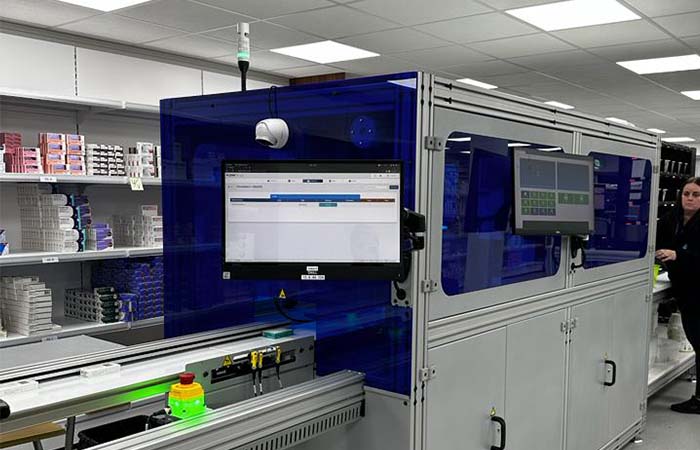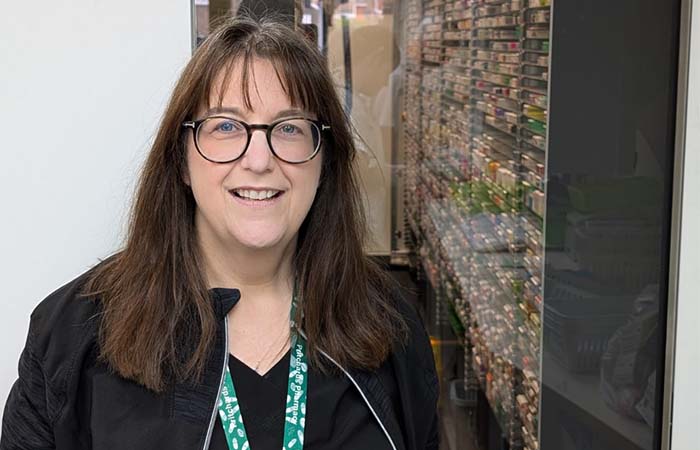Analysis: Will hub and spoke be a financial lifeline?
In Analysis
Follow this topic
Bookmark
Record learning outcomes

With long-awaited hub-and-spoke legislation changes on the way, does automation and centralised dispensing offer a financial lifeline for community pharmacy, or just more complexity? By Saša Janković
The government has laid amendments to the Human Medicines Regulations (HMR) 2012 in Parliament, marking the next step towards enabling hub-and- spoke dispensing between different pharmacy businesses under the ‘Model 1’ pathway of: patient – spoke – hub – spoke – patient.
But will the introduction of Model 1 really help improve business bottom lines in challenging times, or is it a mistake to think this is a one-size-fits-all solution for community pharmacy?
As CEO of HubRx and Pharmacy+Health, it’s no surprise that Daniel Lee welcomes the legislative change. “The NHS wants community pharmacy to offer more clinical services to help better manage demand on GPs and support greater preventative patient care; pharmacy teams want to use their clinical expertise more; and patients are crying out for pharmacy to offer them easier access to NHS and private care,” he says.
“That’s only going to be possible if some of the burden of the 1.1 billion prescription items community pharmacy dispenses each year is released through the greater use of automation and partnerships with experts in hub-and- spoke dispensing.”
Mark Pedder, commercial director of HubRx, says the right hub-and-spoke offering “can absolutely improve a pharmacy’s bottom line through improved at-scale buying margins comparable with the larger chains, and by releasing dispensing capacity for the delivery of more profitable clinical services”, something Pedder says has been proved across the chain of Pharmacy+Health pharmacies.
“Over the last 18 months we’ve introduced the use of HubRx to dispense 60 per cent to 70 per cent of branch prescription volume and as a direct result profitability has continued to grow,” explains Pedder.
“In the first month, when all 33 Pharmacy+Health branches were using HubRx, our delivery of NHS clinical services increased by 65 per cent and we grew our vaccination numbers by 400 per cent in just one year.”
However, Pedder warns that ”not all hub and spoke operations are created equal”. He stresses that “they need proper investment and the right expertise and technology behind them to deliver what community pharmacy needs.”
Cost challenges
And he’s not alone in keeping an eye on financial outcomes. Tariq Muhammad, CEO of Invatech Health, says the main challenge for hub and spoke will now be the commercial model: “Operators will need to attract pharmacy businesses with very low transaction costs and a high standard of service and this may be challenging given the extremely low margins now left in dispensing.”
Even the bigger players are not immune to shouldering the cost, as Company Chemists’Association chief executive Malcolm Harrison points out. “The upfront capital cost of setting up a large assembly facility is huge,” he says. “Equally significant are the ongoing operational costs of maintaining the complex machinery and IT solutions.
"Any return on investment will therefore take many years. With little to no profit available in dispensing NHS medicines, it is hard to see how new facilities could be established, or pharmacies could afford to procure assembly services from third parties.”
The National Pharmacy Association (NPA) also warns that hub and spoke is “no silver bullet as far as pharmacy finances are concerned”. Gareth Jones, director of corporate affairs agrees that although “some independent pharmacies may find hub and spoke to be a useful mechanism for releasing time for patient care, the medium-to-long-term business case only stacks up for local pharmacies if there is an ongoing pipeline of NHS investment in clinical services, to make productive use of the staff time released.”
Business threats
Hatul Shah, CEO of Sigma Pharmaceuticals – one of the UK’s largest independent pharmacy wholesalers – is similarly sceptical that the introduction of Model 1 hub-and-spoke dispensing will universally improve business bottom lines for community pharmacies.
“There’s a tendency to oversell hub and spoke as a cure-all for the pressures facing community pharmacy, and while the reality is that Model 1 may help some businesses, it’s not a one-size-fits-all solution,” says Shah.
One of the biggest threats Shah foresees with Model 1 is “vertical integration”. “If the hubs are owned by large corporates, independents risk handing over part of their dispensing process to a competitor, and that’s not just risky, it’s potentially undermining their entire business model,” he says.
“Using a third-party hub means pharmacies lose an element of control. You’re no longer fully in charge of your supply chain, your timelines, or your margins, and that’s a serious concern, especially in a sector already under financial pressure.”
Indeed, Shah speaks as someone who has actually trialled hub and spoke in his own pharmacies, not just from a theoretical or wholesaler perspective. “We ran it across a couple of our branches, modelling it as if we were a small independent with just one or two stores,” he explains. “The economics simply didn’t stack up. We still needed the same level of staffing to handle acute prescriptions, counsel patients and manage security on the shop floor.”
While there is a perception that for smaller pharmacy groups the only option available to them is a third-party hub, Louise Laban, sales and marketing director at Centred Solutions, says: “That is absolutely not the case. We successfully work with pharmacy groups who have as few as three branches and as many as 200+ branches, and we are also speaking to cohorts of like-minded pharmacy groups who are looking to set up their own co-operative dispensing hub so they keep the benefits and ownership in house.”
Centred Solutions has been providing hub-and-spoke solutions to a range of pharmacy groups for over three years now, with Laban saying the data collected so far shows a range of benefits for pharmacy which include:
- An 81 per cent reduction in payroll costs per item
- 50 per cent of total dispensing volumes (70-80 per cent of repeat dispensing) taken out of branch, creating much needed capacity for services
- An average stock reduction in year one of 50 per cent
- Freeing up a minimum average of four hours pharmacist time per branch per day and 8 hours of dispenser/technician time per branch per day.
“Every pharmacy is different so the findings are based on averages,” says Laban. “We have developed a tool that provides more specific data based on a particular pharmacy’s demographics, and helps bring to life the potential benefits and return on investment for specific pharmacies or groups who are considering hub and spoke.”
Automation considerations
This kind of bespoke data deep-dive is undoubtedly useful for pharmacy owners considering the economic outcomes of hub and spoke, but there are other things which should also be on their radar when it comes to automating more tasks within the pharmacy.
Tracey Robertson, managing director of Cegedim Rx, says owners need to ensure any investment they make in automation is future proofed – “with flexible, scalable technology capable of reacting to service and funding changes, for example, but also proactive in introducing new features based on a deep knowledge of how community pharmacy works.”
She also warns that: “One of the biggest red flags owners need to look for is systems that aren’t agnostic – in other words they only work on their own system and aren’t compatible with any other technology.”
Manju Tahim, community pharmacist and director of pharmacy automation provider Avonnex, is also keen to stress that: “Whether you’re thinking about automating in-house or using a hub-and-spoke model, choosing the right automation is what really matters.
"For independents, setting up spokes can come with big upfront costs – from IT systems and staff training, to major changes in how they work and maybe even having to acquire larger premises. At the end of the day, it’s not just about picking a model, it’s about picking the right automation that fits into your workflow and really supports your team.”
Shah, too, urges independent contractors to take a step back and consider their wider business operations before jumping into costly technological investments.
“Before spending money on automation, pharmacy owners should ask: are we using our existing people and processes as efficiently as possible?” he says.
“Often there are small operational improvements like smarter scheduling, stock management, or patient flow that can make a bigger impact at a lower cost.”
Crucially, Shah notes that sometimes the main barrier to progress is mindset.
“The biggest block to innovation is often the pharmacist themselves,” he admits. “We get stuck in our routines and that stops us from adapting. Changing culture is harder than changing technology, but it’s where true progress starts.”
Case study 1: Pritchards Pharmacy
Community pharmacist Jacqui Campbell, from Pritchards Pharmacy in Prestatyn, became the first community pharmacy in Wales to introduce a pharmacy robot in 2009, which she says significantly enhanced stock control, “automatically flagging products nearing expiry and items stored for extended periods, resulting in the team reporting reduced stress and a more organised working environment”.
After 14 years with her initial robot, Jacqui needed a next-generation solution to match the evolving needs of her business, choosing the SINTESI original pack dispensing robot from Avonnex.
The upgrade enables Jacqui to dedicate 70 per cent of her time to clinical services and patient consultations, while her team manage dispensing alongside the robot.
“There is much talk of hub-and-spoke operations,” she says. “As an independent owner, if I outsourced 50 per cent of my dispensing, I would be heavily dependent on third-party service levels as well having upfront set-up costs.
While this model may suit some, for us investment in our own automation was the right path. One thing is clear: dispensing robots are key, whether used in a hub-and-spoke model or on-site.”
Case study 2: Lo's Pharmacy Group
Lo’s Pharmacy is a family-run group of 39 community pharmacies plus a central hub, based in South Yorkshire.
Brothers Chris and Jonathan Lo introduced a hub-and-spoke model of dispensing over two years ago, choosing Centred Solutions FLOWRx Hub, that checks, pick, labels, sorts, bags and totes original packs for patient prescriptions.
They also rolled out FLOWRx InStore software which connects their branches to the pharmacy hub, providing full visibility and allowing stores to receive bagged medications efficiently with the ability to top up, if needed, in store.
The hub services 30 of the group’s branches and processed just over 255,000 packs in March this year which equates to around 180,000 items, offering a next day turnaround service for all orders sent before 1pm.
“On average, this has freed up at least one member of staff per branch,” says director Chris Lo. “Errors have decreased due to the barcode technology, and in terms of stock the key has been less wastage.
"Instead of 30 pharmacies all having their own stockpile, we now pull drug usage data to inform stock holding and this results in a lower chance of wastage.
“Going forward, as we grow in the number of pharmacies, we can scale our hub operation as needed. It is a crucial resource to help our pharmacies cope with an ever-increasing workload, with services like Pharmacy First now taking centre stage.”


